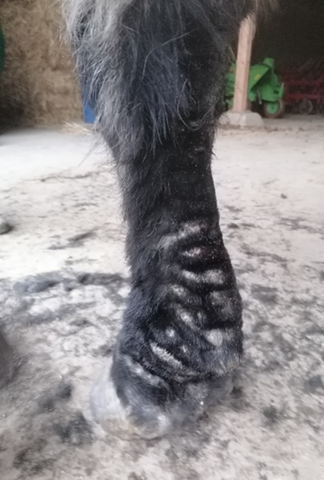The 5 Pillars of Chronic Progressive Lymphedema (CPL) Management
The Natural Way - specialized in itching and skin complaints and the natural treatment of horses with sweet itch, mud fever and CPL.
In this article, guest blogger An Gybels shares by Equi Ikigai provides her insights into appropriate management of horses with Chronic Progressive Lymphedema (CPL).

© Equi Ikigai
What is CPL?
CPL is a hereditary condition that mainly occurs in horses with a lot of feathering, such as draft horses, Friesians, Tinkers, Shires, etc.
The lymphatic vessels of these horses do not work properly due to a lack of elastin in the tissues. As a result, fluid accumulates in the legs and causes all kinds of complaints. The complaints often start at a young age with excessive skin flakes and small folds in the pastern. Small wounds can also occur.
These complaints are often attributed to sulking, while this is actually the beginning of CPL. The complaints are often not noticed at first, because they are hidden under a thick layer of hair.
Do you have a horse that may be at risk of developing CPL? Then regularly examine your horse's pastern.
The earlier you can start treatment, the better. As the horse ages, the complaints worsen.
Skin folds increase in number, the skin becomes stiffer, the structure of the hair changes, lumps appear here and there, fluid accumulates in the legs and the symptoms can now also be found in other parts of the leg.
Typical for a later stage of CPL are the wounds on the back of the front knee and the ridges and wounds on the front of the hock. These are often difficult to heal due to the great flexibility in this area.
Although CPL is an incurable disease, there is still a lot you can do to keep the symptoms within limits and slow the progression.

Chronic Progressive Lymphedema © The Natural Way
We look at ideal management based on 5 pillars.
PILLAR 1: NUTRITION
Good nutrition is the basis of everything. Excessive sugar and starch burden the horse's system and worsen symptoms. Give your horse plenty of high-quality roughage, preferably hay.
Limit grass intake by, for example, strip grazing. Supplement the roughage with a good balancer.
Do not give concentrates containing grains. If your horse needs extra energy, choose grain-free feed that contains less than 10% sugar + starch together.
PRIMARY FOOD (E-book): healthy food for itch-sensitive horses
PILLAR 2: HOUSING AND TRAINING
The lymphatic system does not have a pump like our blood vessel system. The main pump of the lymphatic system is movement.
That is why free movement is crucial for a horse with CPL. Therefore, do not stable a horse with CPL.
Provide a track system with different feeding areas and put your horse together with a friend.
Try to encourage exercise in your daily accommodation.
We often see the complaints of CPL worsen in the winter because horses start to stand still a little more because of mud and bad weather. Try to train your horse. Every move is a win. Go for a nice walk and cycle miles with your horse.
PILLAR 3: SHEARING AND PESTS
If your horse has a lot of wallpaper, this can be quite serious, especially if the socks are wet. A horse has no muscles in its lower leg. Lymphatic vessels run very superficially in the skin of the leg. Due to the amount of wallpaper there is little space in the skin. The weight of all that hair can also push the lymphatic vessels extra closed because the skin runs directly over the bone. Once a thick sock gets wet in the winter, it is difficult to dry. This creates a warm, sultry climate in the pastern cavity and is a feast for all kinds of pests.
Do you often see your horse scratching its legs, biting its legs or stamping its legs? Then there is a good chance that your horse suffers from mites .
The best way to treat your horse is to shave its socks and keep them short. Pests have little chance, the lymphatic vessels are not pushed and you have a good view of your horse's symptoms.
Shaving is one of the most important things in the management of your horse with CPL.

CPL oil © The Natural Way
PILLAR 4: SKIN CARE
Now that you have shaved your horse, it is much easier to care for the skin. It is important to keep ridges caused by CPL supple and to care for any wounds.
The Natural Way has developed CPL oil specifically for this purpose, a 100% natural product for daily and long-term use in all CPL phases: from keeping the skin supple at the first symptoms, to the advanced stages with persistent wrinkles, wounds and parasites.
PILLAR 5: MANUAL LYMPH DRAINAGE (MLD)
Manual lymphatic drainage helps the lymphatic system to function better. After lymphatic drainage, the transport of lymph can increase by up to 75%. By taping at the end of the treatment, the treatment is continued for a while. The tape ensures increased drainage of lymphatic fluid from the legs and can reduce edema. The goal of regular treatment with manual lymphatic drainage is to slow the progression of CPL as much as possible.
In addition, a lymphatic drainage therapist is well trained in guiding horses with CPL and can help you think about the optimal care and management of your horse.
Discover our 100 % natural Zomereczeem lotion, Mok olie, CPL olie, Natuur Shampoo and OERVOER (E-book) about healthy nutrition for itch-sensitive horses HERE.
This article was published on The Natural Way by
Laura Cleirens - 2023.01.08
Last update: 2023.12.28
